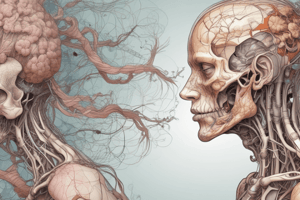Podcast
Questions and Answers
What does the term anatomy mean?
What does the term anatomy mean?
to dissect
What is physiology concerned with?
What is physiology concerned with?
processes and functions
Which type of physiology studies the human organism?
Which type of physiology studies the human organism?
- Cellular Physiology
- Human Physiology (correct)
- Regional Physiology
- Systematic Physiology
Which of the following is NOT a type of anatomy?
Which of the following is NOT a type of anatomy?
What is homeostasis?
What is homeostasis?
What is the normal range in terms of homeostasis?
What is the normal range in terms of homeostasis?
What is meant by 'set point' in homeostasis?
What is meant by 'set point' in homeostasis?
Reproduction only involves the formation of new organisms.
Reproduction only involves the formation of new organisms.
Which process refers to changes from generalized to specified?
Which process refers to changes from generalized to specified?
What ability does responsiveness provide the body?
What ability does responsiveness provide the body?
Flashcards are hidden until you start studying
Study Notes
Anatomy and Physiology
- Anatomy investigates body structures, derived from a term meaning "to dissect."
- Physiology examines processes and functions of the body.
- Human Physiology focuses specifically on the human organism.
- Systematic Physiology studies body-organ systems.
- Cellular Physiology centers on the study of body cells.
Importance of Anatomy and Physiology
- Understanding how the body responds to stimuli essential for health.
- Crucial for recognizing reactions to environmental changes, cues, diseases, and injuries.
Types of Anatomy
- Systematic Anatomy examines body-organ systems.
- Regional Anatomy focuses on specific body regions; commonly used in medical education.
- Surface Anatomy analyzes external features, such as bone projections.
- Anatomical Imaging utilizes technologies like X-rays, ultrasound, and MRI for visualization.
Characteristics of Life
- Responsiveness: Ability to sense and respond to environmental changes, encompassing both internal and external factors.
- Growth: Involves an increase in size at cellular or tissue levels.
- Development: Signifies changes in form and function, transitioning from generalized to specialized cells.
- Reproduction: Encompasses the formation of new cells and organisms, contributing to tissue repair and individual generation.
Homeostasis
- Definition: Maintenance of a constant internal environment despite external or internal fluctuations.
- Variables: Body properties that vary in value, such as body temperature, heart rate, blood pressure, blood glucose levels, and respiratory rate.
- Over time, body temperature fluctuates around a designated set point.
- Normal Range: The acceptable extent of deviation around the set point.
- Set Point: The normal or average value of a physiological variable.
- Set points for certain variables can adjust temporarily based on body activities or needs.
Studying That Suits You
Use AI to generate personalized quizzes and flashcards to suit your learning preferences.




